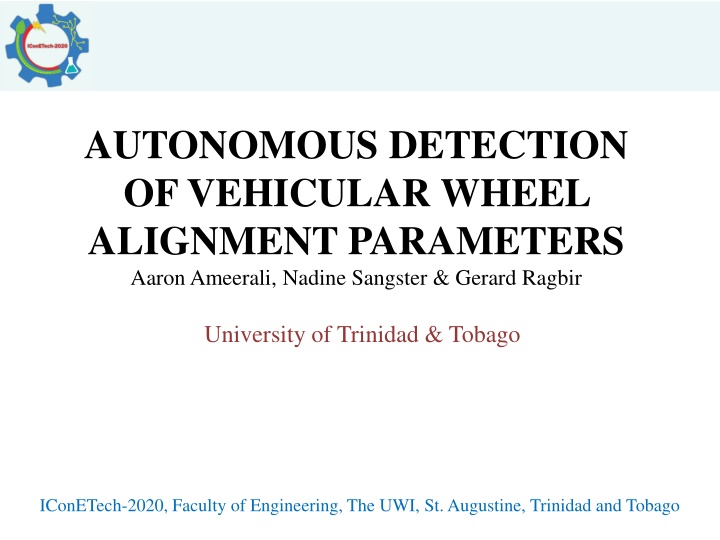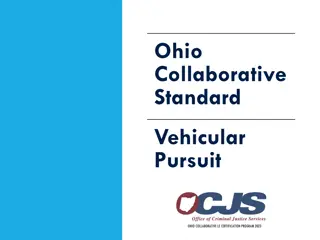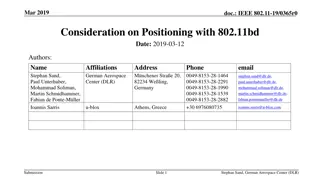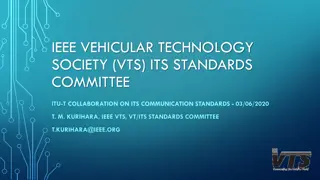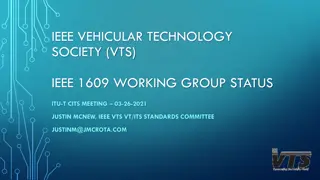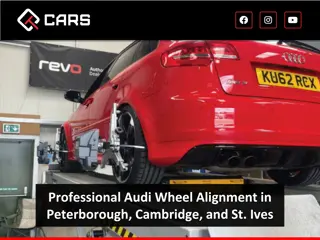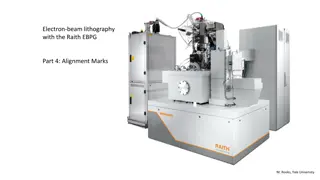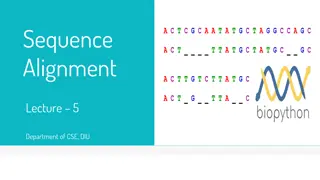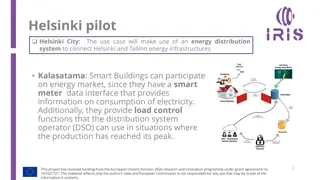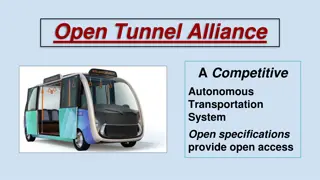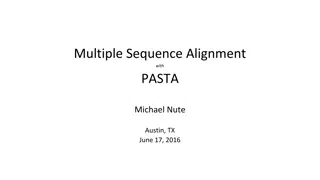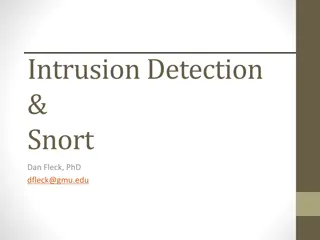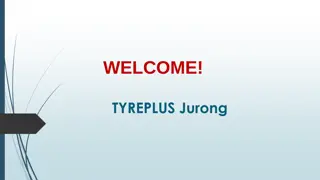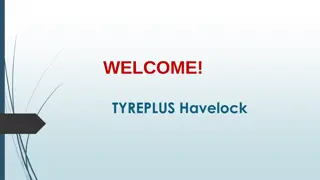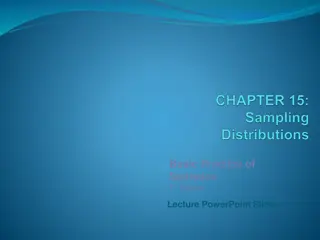Autonomous Detection of Vehicular Wheel Alignment Parameters
This research focuses on the autonomous detection of vehicular wheel alignment parameters conducted by Aaron Ameerali, Nadine Sangster, and Gerard Ragbir at the University of Trinidad & Tobago. The study addresses the importance of wheel alignment for proper road contact and maintenance, discussing parameters such as Camber, Toe, and Caster. Objectives include identifying detection methods and developing a device for evaluating alignment. The methodology involves functional analysis to benchmark against existing methods.
Download Presentation

Please find below an Image/Link to download the presentation.
The content on the website is provided AS IS for your information and personal use only. It may not be sold, licensed, or shared on other websites without obtaining consent from the author.If you encounter any issues during the download, it is possible that the publisher has removed the file from their server.
You are allowed to download the files provided on this website for personal or commercial use, subject to the condition that they are used lawfully. All files are the property of their respective owners.
The content on the website is provided AS IS for your information and personal use only. It may not be sold, licensed, or shared on other websites without obtaining consent from the author.
E N D
Presentation Transcript
AUTONOMOUS DETECTION OF VEHICULAR WHEEL ALIGNMENT PARAMETERS Aaron Ameerali, Nadine Sangster & Gerard Ragbir University of Trinidad & Tobago IConETech-2020, Faculty of Engineering, The UWI, St. Augustine, Trinidad and Tobago
OVERVIEW Introducing the Problem Research Objectives Methodology Discussion of Findings Conclusion IConETech-2020, Faculty of Engineering, The UWI, St. Augustine, Trinidad and Tobago
INTRODUCTION Wheel Alignment, ensures proper contact with the road considered necessary maintenance Types Front-Wheel or Four-Wheel Alignment Parameters Camber, Toe, Caster (sometimes Castor) IConETech-2020, Faculty of Engineering, The UWI, St. Augustine, Trinidad and Tobago
INTRODUCTION Camber viewed from front plane top leans toward vehicle NEGATIVE CAMBER top leans away from vehicle POSITIVE CAMBER affects contact area with the road trades between straight line motion and cornering IConETech-2020, Faculty of Engineering, The UWI, St. Augustine, Trinidad and Tobago
INTRODUCTION Toe determined from a birds-eye-view forward parts lean toward each other TOE IN front parts lean away from each other TOE OUT can lead to understeer and oversteer IConETech-2020, Faculty of Engineering, The UWI, St. Augustine, Trinidad and Tobago
INTRODUCTION Caster/Castor angles do not indicate misalignment affects manoeuvrability leans away from the front positive caster leans toward the front of the vehicle negative caster IConETech-2020, Faculty of Engineering, The UWI, St. Augustine, Trinidad and Tobago
OBJECTIVES To identify possible methods for detecting alignment. To evaluate, design and develop a device for detecting: Camber Caster/Castor Toe Benchmark the design against existing method/s. IConETech-2020, Faculty of Engineering, The UWI, St. Augustine, Trinidad and Tobago
METHODOLOGY Functional Analysis IConETech-2020, Faculty of Engineering, The UWI, St. Augustine, Trinidad and Tobago
METHODOLOGY Morphological Chart Table: Showing parametric combinations Energy/Data Method Wired Wireless Sensor Method Electric Magnetic Acoustic Optical MEMS Suspension Type McPherson Strut Double Wishbone Multi-Link Alignment 2-Wheel Alignment 4-Wheel Alignment Mounting Method Mounting Bracket Fixed Mounting Arm Adhesive Decision after a Pugh Screening Analysis: Wired MEMs Double Wishbone Front Wheel Fixed IConETech-2020, Faculty of Engineering, The UWI, St. Augustine, Trinidad and Tobago
METHODOLOGY Selected Design Concept IConETech-2020, Faculty of Engineering, The UWI, St. Augustine, Trinidad and Tobago
METHODOLOGY Front Wheel Sensor - R Calibration Sensor Front Wheel Sensor - L Steering Wheel Angle was determined from a sensor on the steering wheel. IConETech-2020, Faculty of Engineering, The UWI, St. Augustine, Trinidad and Tobago
METHODOLOGY Acoustic Optical IConETech-2020, Faculty of Engineering, The UWI, St. Augustine, Trinidad and Tobago
RESULTS Table: Camber Results Left Reading Left Camber Right Reading Right Camber Actual Left Camber Actual Right Camber Intended Camber Reference 232.05 232.06 0.01 232.03 0.02 -0.10 0.00 0 232.07 230.93 -1.14 233.01 -0.94 -1.20 -1.30 -1 232.02 229.96 -2.06 234.07 -2.05 -2.00 -2.20 -2 232.03 229.01 -3.03 235.05 -3.02 -2.90 -3.10 -3 232.07 233.08 1.01 230.98 1.09 1.00 0.90 1 232.08 234.01 1.94 230.01 2.07 2.00 2.00 2 232.07 235.41 3.34 228.98 3.09 3.20 3.10 3 *Summarized from a larger data set. IConETech-2020, Faculty of Engineering, The UWI, St. Augustine, Trinidad and Tobago
RESULTS Left Right Intended 4 3 2 1 Measured Value/ 0 -3 -2 -1 0 1 2 3 -1 -2 -3 -4 Calibrated Value/ Figure: Camber Results IConETech-2020, Faculty of Engineering, The UWI, St. Augustine, Trinidad and Tobago
RESULTS Table: Toe values for IMU & Benchmark Left IMU Right IMU Toe (IMU) Left Cal Right Cal Toe (CAL) -0.06 2.06 -3.45 -3.23 3.01 -0.44 1.27 8.38 -7.62 -0.85 -0.10 2.54 -4.19 -0.44 -0.04 0.74 3.02 7.02 -7.74 7.20 OUT IN OUT OUT IN Neutral IN IN OUT OUT 0.0 1.5 -4.0 -3.0 3.0 -0.5 1.5 8.0 -7.5 -1.0 0.0 2.0 -4.0 0.0 0.0 0.5 3.0 7.0 -7.5 7.0 Neutral IN OUT OUT IN Neutral IN IN OUT IN IConETech-2020, Faculty of Engineering, The UWI, St. Augustine, Trinidad and Tobago
RESULTS Caster/Castor adjustable usually in sports and high-end cars unable to get access or permission to a vehicle simulated data by using a manually adjustable rig rig could not be used with the machine used for benchmarking measurement deltas were within a 1 range on the rig IConETech-2020, Faculty of Engineering, The UWI, St. Augustine, Trinidad and Tobago
CONCLUSION Evaluated methods of detecting alignment parameters. Acoustic Optical MEMS Designed & Implemented a device for their detection. MEMS Selected IMU sensor Calibrated and benchmarked device against a known standard. Calibrated against a calibration sensor. Benchmarked against Hunter ProAlign Machine. IConETech-2020, Faculty of Engineering, The UWI, St. Augustine, Trinidad and Tobago
REFERENCES Knowles, D. (2002). Automotive Suspension and Steering Systems (3rd ed.). Cengage Learning. Reimpell, J., Stoll, H., & Betzler, J. (2001). The Automotive Chassis: Engineering Principles (2nd ed.). (A. Limited, Trans.) Woburn, MA: Society of Automotive Engineers. Society of Automotive Engineers. (2013). Vehicle Alignment Basics. SAE. Genta, G., & Morello, L. (2009). The Automotive Chassis (Vol. 1 & Vol. 2). (F. F. Ling, Ed.) Torino, Italy: Springer. IConETech-2020, Faculty of Engineering, The UWI, St. Augustine, Trinidad and Tobago
THANK YOU! IConETech-2020, Faculty of Engineering, The UWI, St. Augustine, Trinidad and Tobago
